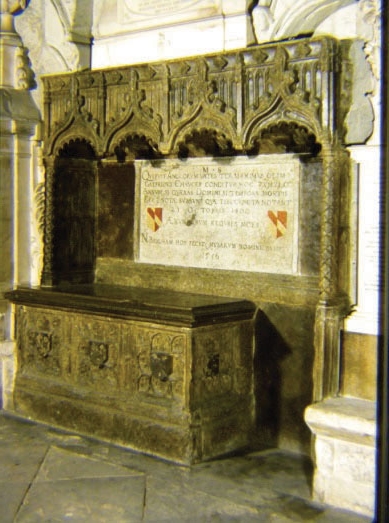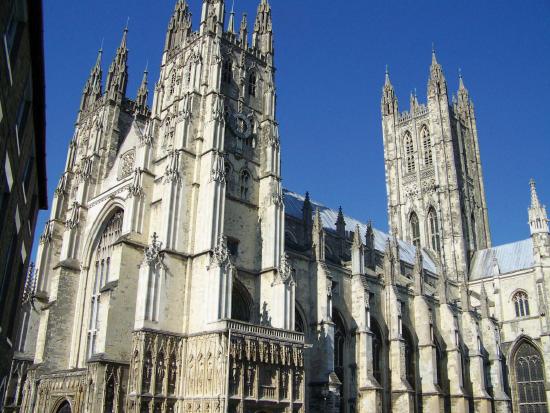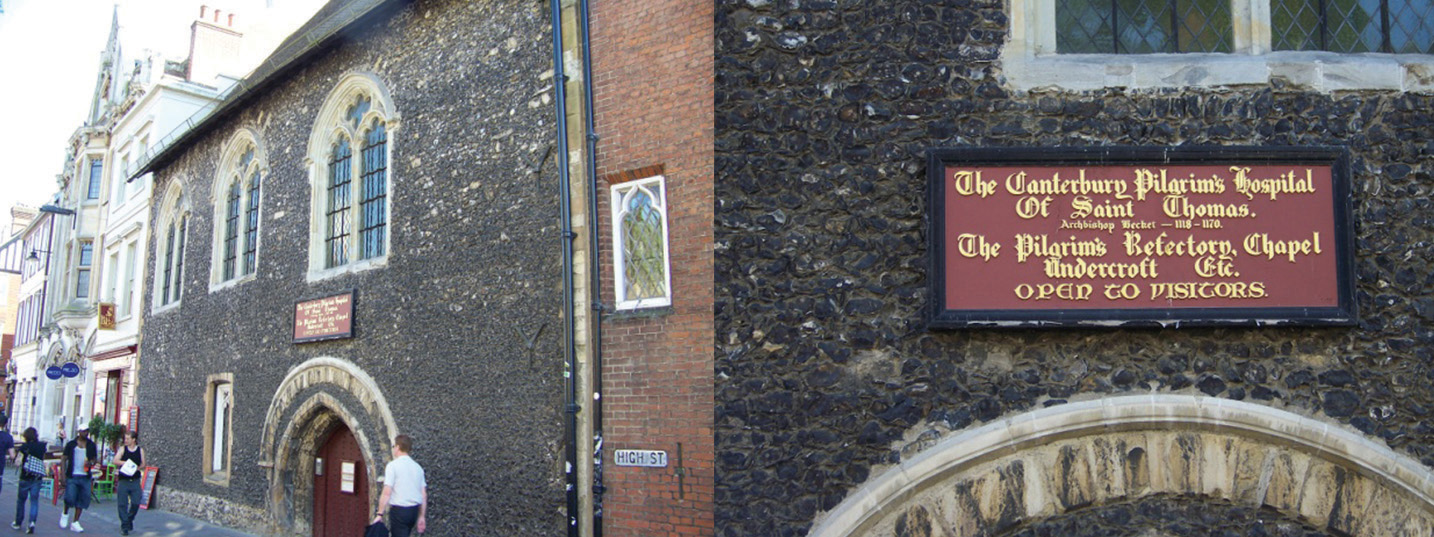1.5: Geoffrey Chaucer (1343–1400)
- Page ID
- 76667
\( \newcommand{\vecs}[1]{\overset { \scriptstyle \rightharpoonup} {\mathbf{#1}} } \)
\( \newcommand{\vecd}[1]{\overset{-\!-\!\rightharpoonup}{\vphantom{a}\smash {#1}}} \)
\( \newcommand{\dsum}{\displaystyle\sum\limits} \)
\( \newcommand{\dint}{\displaystyle\int\limits} \)
\( \newcommand{\dlim}{\displaystyle\lim\limits} \)
\( \newcommand{\id}{\mathrm{id}}\) \( \newcommand{\Span}{\mathrm{span}}\)
( \newcommand{\kernel}{\mathrm{null}\,}\) \( \newcommand{\range}{\mathrm{range}\,}\)
\( \newcommand{\RealPart}{\mathrm{Re}}\) \( \newcommand{\ImaginaryPart}{\mathrm{Im}}\)
\( \newcommand{\Argument}{\mathrm{Arg}}\) \( \newcommand{\norm}[1]{\| #1 \|}\)
\( \newcommand{\inner}[2]{\langle #1, #2 \rangle}\)
\( \newcommand{\Span}{\mathrm{span}}\)
\( \newcommand{\id}{\mathrm{id}}\)
\( \newcommand{\Span}{\mathrm{span}}\)
\( \newcommand{\kernel}{\mathrm{null}\,}\)
\( \newcommand{\range}{\mathrm{range}\,}\)
\( \newcommand{\RealPart}{\mathrm{Re}}\)
\( \newcommand{\ImaginaryPart}{\mathrm{Im}}\)
\( \newcommand{\Argument}{\mathrm{Arg}}\)
\( \newcommand{\norm}[1]{\| #1 \|}\)
\( \newcommand{\inner}[2]{\langle #1, #2 \rangle}\)
\( \newcommand{\Span}{\mathrm{span}}\) \( \newcommand{\AA}{\unicode[.8,0]{x212B}}\)
\( \newcommand{\vectorA}[1]{\vec{#1}} % arrow\)
\( \newcommand{\vectorAt}[1]{\vec{\text{#1}}} % arrow\)
\( \newcommand{\vectorB}[1]{\overset { \scriptstyle \rightharpoonup} {\mathbf{#1}} } \)
\( \newcommand{\vectorC}[1]{\textbf{#1}} \)
\( \newcommand{\vectorD}[1]{\overrightarrow{#1}} \)
\( \newcommand{\vectorDt}[1]{\overrightarrow{\text{#1}}} \)
\( \newcommand{\vectE}[1]{\overset{-\!-\!\rightharpoonup}{\vphantom{a}\smash{\mathbf {#1}}}} \)
\( \newcommand{\vecs}[1]{\overset { \scriptstyle \rightharpoonup} {\mathbf{#1}} } \)
\( \newcommand{\vecd}[1]{\overset{-\!-\!\rightharpoonup}{\vphantom{a}\smash {#1}}} \)
\(\newcommand{\avec}{\mathbf a}\) \(\newcommand{\bvec}{\mathbf b}\) \(\newcommand{\cvec}{\mathbf c}\) \(\newcommand{\dvec}{\mathbf d}\) \(\newcommand{\dtil}{\widetilde{\mathbf d}}\) \(\newcommand{\evec}{\mathbf e}\) \(\newcommand{\fvec}{\mathbf f}\) \(\newcommand{\nvec}{\mathbf n}\) \(\newcommand{\pvec}{\mathbf p}\) \(\newcommand{\qvec}{\mathbf q}\) \(\newcommand{\svec}{\mathbf s}\) \(\newcommand{\tvec}{\mathbf t}\) \(\newcommand{\uvec}{\mathbf u}\) \(\newcommand{\vvec}{\mathbf v}\) \(\newcommand{\wvec}{\mathbf w}\) \(\newcommand{\xvec}{\mathbf x}\) \(\newcommand{\yvec}{\mathbf y}\) \(\newcommand{\zvec}{\mathbf z}\) \(\newcommand{\rvec}{\mathbf r}\) \(\newcommand{\mvec}{\mathbf m}\) \(\newcommand{\zerovec}{\mathbf 0}\) \(\newcommand{\onevec}{\mathbf 1}\) \(\newcommand{\real}{\mathbb R}\) \(\newcommand{\twovec}[2]{\left[\begin{array}{r}#1 \\ #2 \end{array}\right]}\) \(\newcommand{\ctwovec}[2]{\left[\begin{array}{c}#1 \\ #2 \end{array}\right]}\) \(\newcommand{\threevec}[3]{\left[\begin{array}{r}#1 \\ #2 \\ #3 \end{array}\right]}\) \(\newcommand{\cthreevec}[3]{\left[\begin{array}{c}#1 \\ #2 \\ #3 \end{array}\right]}\) \(\newcommand{\fourvec}[4]{\left[\begin{array}{r}#1 \\ #2 \\ #3 \\ #4 \end{array}\right]}\) \(\newcommand{\cfourvec}[4]{\left[\begin{array}{c}#1 \\ #2 \\ #3 \\ #4 \end{array}\right]}\) \(\newcommand{\fivevec}[5]{\left[\begin{array}{r}#1 \\ #2 \\ #3 \\ #4 \\ #5 \\ \end{array}\right]}\) \(\newcommand{\cfivevec}[5]{\left[\begin{array}{c}#1 \\ #2 \\ #3 \\ #4 \\ #5 \\ \end{array}\right]}\) \(\newcommand{\mattwo}[4]{\left[\begin{array}{rr}#1 \amp #2 \\ #3 \amp #4 \\ \end{array}\right]}\) \(\newcommand{\laspan}[1]{\text{Span}\{#1\}}\) \(\newcommand{\bcal}{\cal B}\) \(\newcommand{\ccal}{\cal C}\) \(\newcommand{\scal}{\cal S}\) \(\newcommand{\wcal}{\cal W}\) \(\newcommand{\ecal}{\cal E}\) \(\newcommand{\coords}[2]{\left\{#1\right\}_{#2}}\) \(\newcommand{\gray}[1]{\color{gray}{#1}}\) \(\newcommand{\lgray}[1]{\color{lightgray}{#1}}\) \(\newcommand{\rank}{\operatorname{rank}}\) \(\newcommand{\row}{\text{Row}}\) \(\newcommand{\col}{\text{Col}}\) \(\renewcommand{\row}{\text{Row}}\) \(\newcommand{\nul}{\text{Nul}}\) \(\newcommand{\var}{\text{Var}}\) \(\newcommand{\corr}{\text{corr}}\) \(\newcommand{\len}[1]{\left|#1\right|}\) \(\newcommand{\bbar}{\overline{\bvec}}\) \(\newcommand{\bhat}{\widehat{\bvec}}\) \(\newcommand{\bperp}{\bvec^\perp}\) \(\newcommand{\xhat}{\widehat{\xvec}}\) \(\newcommand{\vhat}{\widehat{\vvec}}\) \(\newcommand{\uhat}{\widehat{\uvec}}\) \(\newcommand{\what}{\widehat{\wvec}}\) \(\newcommand{\Sighat}{\widehat{\Sigma}}\) \(\newcommand{\lt}{<}\) \(\newcommand{\gt}{>}\) \(\newcommand{\amp}{&}\) \(\definecolor{fillinmathshade}{gray}{0.9}\)Learning Objectives
- Explain the literary techniques Chaucer uses that distinguish Canterbury Tales from collections of unrelated stories.
- List and define types of tales used in Canterbury Tales.
- Categorize individual tales.
- Identify the social strata to which each pilgrim belongs and correlate the description of each character with the tale he/she tells.
“He [Chaucer] must have been a man of a most wonderful comprehensive nature, because, as has been truly observed of him, he has taken into the compass of his Canterbury Tales the various manners and humours (as we now call them) of the whole English nation in his age … 'tis sufficient to say, according to the old proverb, that here is God's plenty.” -John Dryden
With this quotation, John Dryden, 17th-century poet, essayist, and literary critic, encapsulates what many consider to be one of the prominent features of Chaucer’s work: The Canterbury Tales pictures the medieval world with a richness of description that makes it vibrant and alive. "The General Prologue" introduces individuals from every level of society—peasant, nobleman, clergy, and the new middle class—with vividness and detail.

Biography

Geoffrey Chaucer (c. 1343–1400) was born into an apparently prosperous merchant family. As a boy he served as a page to a noble family and throughout his life worked in increasingly more prominent government positions. Chaucer’s wife Phillipa was the sister of John of Gaunt’s third wife Katherine, who had been a governess to the children of John and his wife Blanche. John of Gaunt, a wealthy and politically powerful younger son of King Edward III, became Chaucer’s patron. Whether through this family connection or on his own merit, Chaucer maintained a comfortable life through his position in the court. Chaucer’s poem The Book of the Duchess was written to commemorate the death of John of Gaunt’s wife Blanche.
When Chaucer died in 1400, he was buried in Westminster Abbey, an indication of his high social status. His tomb in the south transept of Westminster Abbey began the tradition of Poet’s Corner.


Text in Modern English Translation
- The Canterbury Tales. Michael Murphy. Brooklyn College, City University of New York. “The General Prologue” and selected tales in Middle English with “reader-friendly” prose translations. http://academic.brooklyn.cuny.edu/webcore/murphy/canterbury/canterbury.htm
- “The Canterbury Tales and Other Works.” Librarius. side-by-side translations. http://www.librarius.com/
- “Canterbury Tales: Prologue [Parallel Texts].” Internet Medieval Sourcebook. Paul Halsall. Fordham University. parallel edition of “The General Prologue.” http://www.fordham.edu/halsall/source/CT-prolog-para.html
- “ELF Presents The Canterbury Tales.” The Electronic Literature Foundation. www.canterburytales.org/canterbury_tales.html
- “Interlinear Translations of Some of The Canterbury Tales.” Geoffrey Chaucer Page. L.D. Benson. Harvard University. interlinear translations. www.courses.fas.harvard.edu/~chaucer/teachslf/tr-index.htm
Text in Middle English
- “Chaucer Texts.” eChaucer: Chaucer in the Twenty-First Century. Gerard NeCastro. University of Maine at Machias. Middle English text and prose translations. www.umm.maine.edu/faculty/necastro/chaucer/texts/
- The Canterbury Tales, and Other Poems. Project Gutenberg. www.gutenberg.org/catalog/world/readfile?fk_files=1448814&pageno=26
- Corpus of Middle English Prose and Verse. University of Michigan Library Digital Collections. http://quod.lib.umich.edu/cgi/t/text/text-idx?c=cme;idno=CT
- “Selected Poetry of Geoffrey Chaucer.” Representative Poetry Online. Ian Lancashire. Department of English. University of Toronto. rpo.library.utoronto.ca/poet/61.html
Audio
- “The Canterbury Tales.” Ed. D. Laing Purves (1838–1873). Librivox. complete audio files. http://librivox.org/the-canterbury-tales-by-geoffrey-chaucer/
- “The Canterbury Tales Audio Links.” Librarius. selected audio files. http://www.librarius.com/cantlink/audiofs.htm
- “Chaucer Canterbury Tales.” Luminarium. Anniina Jokinen. selected audio files. http://www.luminarium.org/medlit/canterbury.htm
- The Chaucer Metapage Audio Files. Virginia Military Institute. Audio files of “The General Prologue,” “The Knight’s Tale,” “The Miller’s Tale,” “The Wife of Bath’s Tale,” “The Envoy to the Clerk’s Tale,” “The Pardoner’s Tale,” and “The Nun’s Priest Tale.” http://www.vmi.edu/fswebs.aspx?tid=34099&id=34249
Types of Tales
Chaucer uses several types of tales typical in the Middle Ages.
- medieval romance—a narrative with the following characteristics:
- a plot about knights and their adventures
- improbable, often supernatural elements
- inclusion of the conventions of courtly love
- standardized characters (the same types of characters appearing in many stories: the chivalrous knight; the beautiful lady; the mysterious old hag)
- repeated events, often repeated in numbers with religious significance such as three
- examples of medieval romances in The Canterbury Tales: “The Knight’s Tale,” “The Wife of Bath’s Tale” (an Arthurian romance)
- fabliau—a humorous, bawdy tale, often including satire of foolish characters
- examples of fabliaux in The Canterbury Tales: “The Miller’s Tale,” “The Reeve’s Tale,” “The Summoner’s Tale”
- exemplum—a moral tale, often used to illustrate a point in a sermon
- examples of exempla in The Canterbury Tales: “The Clerk’s Tale,” “The Pardoner’s Tale,” “The Monk’s Tale”
- saint’s legend—a story depicting the life and martyr’s death of a saint
- examples of saints’ legends in The Canterbury Tales: “The Prioress’s Tale,” “The Second Nun’s Tale”
- beast epic—a fable, often allegorical, that features animal characters
- example of a beast epic in The Canterbury Tales: “The Nun’s Priest’s Tale”
Many of the tales Chaucer uses in The Canterbury Tales are not his original stories. Many come from other sources or are traditional stories. Chaucer’s originality is in his artful use of the material to create a unified work that portrays a vast array of medieval characters.
“The General Prologue”
Although collections of stories were not uncommon in the Middle Ages, Chaucer's Canterbury Tales are unique because they are more than a collection of unrelated tales; Chaucer produces a unified work through two techniques. First, he uses a framework, a narrative that contains another narrative: in Canterbury Tales, the fiction of the pilgrims on a pilgrimage that provides the structure and the rationale for the various tales. Thus the various stories form a whole fiction. Second, Chaucer provides links, conversations among the various pilgrims between the stories to tie the stories together.
The first component of the framework is “The General Prologue” which introduces characters who tell the stories and who continue to function as characters in the links between the tales. In the first few lines Chaucer sets the stage, explaining the setting and the situation:
Note
Whan that Aprille, with hise shoures soote,
The droghte of March hath perced to the roote,
And bathed euery veyne in swich licour,
Of which vertu engendred is the flour;
Whan Zephirus eek with his swete breeth
Inspired hath in euery holt and heath
The tendre croppes and the yonge sonne
Hath in the Ram his halfe cours yronne,
And smale foweles maken melodye,
That slepen al the nyght with open eye,
So priketh hem nature in hir corages;
Thanne longen folk to goon on pilgrimages,
And Palmeres for to seken straunge strondes,
To ferne halwes kowthe in sondry londes
And specially, from euery shires ende
Of Engelond, to Caunturbury they wende,
The hooly blisful martir for to seke,
That hem hath holpen, whan þat they were secke.
from Frederick J. Furnivall’s edition of the Ellesmere Manuscript, 1868
These lines tell us that the pilgrims are on their way to Canterbury Cathedral. The following presentation provides pictures of and information about Canterbury Cathedral.

Canterbury Cathedral.
Thomas Becket and the reason Chaucer’s pilgrims are traveling to Canterbury Cathedral. " href="http://www.youtube.com/v/2KVcMjtgb8Q" onclick="return replaceIframe(this)">(click to see video)
The following study guide to “The General Prologue” will help identify key features of each of the pilgrims Chaucer introduces in the prologue.

Eastbridge “Hospital" (a place of hospitality) in Canterbury where pilgrims to Canterbury Cathedral found food and shelter, built in the late 12th century.
Selected Individual Tales
“The Miller’s Tale”
An interlinear translation by Larry D. Benson is available on the Harvard Geoffrey Chaucer website.
“The Miller’s Tale” is an example of a fabliau. Fabliaux often involve students from the two great British medieval universities, Oxford and Cambridge, such as Nicholas, the Oxford student in “The Miller’s Tale.” (Only males attended medieval universities.) Many fabliaux probably were composed by students. Modern students may be surprised to learn that people of the Middle Ages thought college students might be involved in pursuing women, drinking, and playing pranks, or in making up stories that involved these activities. Or maybe modern college students would think that students haven’t changed much throughout the ages!
In “The Miller’s Tale” Chaucer brings together two plots from traditional stories:
- a student creates an opportunity to sleep with a woman by convincing her husband that Noah’s flood is about to be repeated
- a lover who is tricked into a humiliating misdirected kiss takes vengeance on his tormentor
These are traditional plots; Chaucer may or may not have been the first to write them. However, their union, culminating in Nicholas’s cry “Water,” is brilliantly handled by Chaucer.
“The Wife of Bath’s Tale”
The text of “The Wife of Bath’s Tale” is available on the Litrix Reading Room website.
“The Wife of Bath’s Tale” is a medieval romance, specifically an Arthurian romance. Not a major character in the tale, King Arthur appears in the story to pass judgment on the guilty knight, only to have his Queen Guinevere ask him to change his ruling. Thus, King Arthur’s giving in to the Queen’s desire is the first intimation of the lesson the errant knight must learn.
The Wife of Bath’s character and her tale have been seen as a reaction to the anti-feminism cultivated by the medieval church. Note the characters who interrupt her prologue and tale. Also often referred to as “the first feminist,” the Wife of Bath, as an actual medieval woman, would have had no concept of modern feminist viewpoints.
“The Clerk’s Tale”
An interlinear translation by Larry D. Benson is available on the Harvard Geoffrey Chaucer website.
Chaucer’s Clerk is also an Oxford student, but one much different from the gallant rascal Nicholas in the Miller’s story. A charity student, the Clerk has taken lower orders in the Church and studies philosophy. Serious about his studies, the Clerk has neither time for pranks nor money for drink; Chaucer in “The General Prologue” tells us that he spends his money on books. Another significant description of the Clerk is Chaucer’s assertion: “Gladly would he learn and gladly teach.”
“The Clerk’s Tale” with its apparent admonition about wives being submissive to their husbands is often contrasted with “The Wife of Bath’s Tale.” However, the fifth and sixth stanzas from the end of the tale reveal the Clerk’s real point in telling this story. Even the Clerk himself says that it would be unthinkable for wives to react as Griselda did, and he then establishes his story as an exemplum by explaining its religious lesson.
Key TakeawayS
- Chaucer’s Canterbury Tales provides a vivid description of life in the Middle Ages by picturing in detail characters from every level of medieval society.
- Chaucer moves beyond the traditional collection of unrelated tales by making Canterbury Tales a unified whole through the use of literary techniques such as the framework of the pilgrimage, links, and the matching of a tale’s content to the personality of the pilgrim who tells it.
- Various types of tales such as medieval romance, fabliau, exemplum, saint’s legend, and beast epic make up Canterbury Tales.
EXERCISES
- Although collections of stories were not uncommon in the Middle Ages, Chaucer's Canterbury Tales are unique because they are more than a collection of unrelated tales; Chaucer produces a unified work through two techniques. First, he uses the framework of the pilgrimage to make the various stories part of a whole fiction. Part of that framework consists of conversations among the various characters between the stories to help tie the stories together. These bits of conversation which tie the stories together are called links. Locate examples of links. Explain the content of each link and evaluate the effectiveness of the link in relating the characters and the stories to each other.
- Another technique Chaucer used to make Canterbury Tales a unified work is the careful choosing of a story that is appropriate for the character who tells it. Chaucer introduces each character in the "General Prologue," and then he frequently adds information in the links or in the character's prologue to his/her story that helps complete the portrait of that person. The story told by the Miller, for example, is just the type of story we expect him to tell because of what we know about his personality. Analyze the elements that make "The Miller's Tale," "The Wife of Bath's Tale," and "The Clerk's Tale" appropriate for those characters.
- After hearing the recordings and seeing the visual examples of the Old English of Beowulf in Chapter 1 and the Middle English of Chaucer, compare and contrast these two precursors of the modern English language.
- Why did Chaucer choose Canterbury Cathedral as the destination for his pilgrims?
Resources: Geoffrey Chaucer (1343–1400)
General Resources
- Chaucer Canterbury Tales. Anniina Jokinen. Luminarium. Links to the text, images, audio, and scholarly sources. http://www.luminarium.org/medlit/canterbury.htm
- Chaucer MetaPage. International Congress of Medieval Studies and University of North Carolina at Chapel Hill. Links to the text, images, audio, scholarly sources, and other Chaucer websites. englishcomplit.unc.edu/chaucer/index.html
- Geoffrey Chaucer Page. Harvard University. Biographical information, background information, interlinear translations, glossary. www.courses.fas.harvard.edu/~chaucer/
- “Pardoners and Indulgences.” Treasures in Full: Caxton’s Chaucer. British Library. Image of the Pardoner and information on medieval indulgences. http://www.bl.uk/treasures/caxton/pardoners.html
Biography
- “Chaucer.” Bartleby.com. rpt. from The Cambridge History of English and American Literature in 18 Volumes (1907–21). Volume II. The End of the Middle Ages. http://www.bartleby.com/212/0701.html
- “Chaucer Chronology.” eChaucer: Chaucer in the Twenty-First Century. Gerard NeCastro. University of Maine at Machias. www.umm.maine.edu/faculty/necastro/chaucer/chronology/
- “Geoffrey Chaucer (c1343–1400).” Anniina Jokinen. Luminarium. rpt. from A. W. Pollard. "Geoffrey Chaucer." Encyclopedia Britannica, 11th Ed., Vol. VI. Cambridge: Cambridge University Press, 1910. 17–22. http://www.luminarium.org/medlit/chaucerbio.htm
- “The Life of Chaucer.” Geoffrey Chaucer Page. Harvard University. courses.fas.harvard.edu/~chaucer/special/varia/life_of_Ch/ch-life.html/
Text in Modern English Translation
- The Canterbury Tales. Michael Murphy. Brooklyn College, City University of New York. “The General Prologue” and selected tales in Middle English with “reader-friendly” prose translations. http://academic.brooklyn.cuny.edu/webcore/murphy/canterbury/canterbury.htm
- “The Canterbury Tales and Other Works.” Librarius. side-by-side translations. http://www.librarius.com/
- “Canterbury Tales: Prologue [Parallel Texts].” Internet Medieval Sourcebook. Paul Halsall. Fordham University. parallel edition of “The General Prologue.” http://www.fordham.edu/halsall/source/CT-prolog-para.html
- “ELF Presents The Canterbury Tales.” The Electronic Literature Foundation. www.canterburytales.org/canterbury_tales.html
- “Interlinear Translations of Some of The Canterbury Tales.” Geoffrey Chaucer Page. L.D. Benson. Harvard University. interlinear translations. www.courses.fas.harvard.edu/~chaucer/teachslf/tr-index.htm
Text in Middle English
- “Chaucer Texts.” eChaucer: Chaucer in the Twenty-First Century. Gerard NeCastro. University of Maine at Machias. Middle English text and prose translations. www.umm.maine.edu/faculty/necastro/chaucer/texts/
- The Canterbury Tales, and Other Poems. Project Gutenberg. www.gutenberg.org/catalog/world/readfile?fk_files=1448814&pageno=26
- Corpus of Middle English Prose and Verse. University of Michigan Library Digital Collections. http://quod.lib.umich.edu/cgi/t/text/text-idx?c=cme;idno=CT
- “Selected Poetry of Geoffrey Chaucer.” Representative Poetry Online. Ian Lancashire. Department of English. University of Toronto. rpo.library.utoronto.ca/poet/61.html
Audio
- “The Canterbury Tales.” Ed. D. Laing Purves (1838–1873). Librivox. complete audio files. http://librivox.org/the-canterbury-tales-by-geoffrey-chaucer/
- “The Canterbury Tales Audio Links.” Librarius. selected audio files. http://www.librarius.com/cantlink/audiofs.htm
- “Chaucer Canterbury Tales.” Luminarium. Anniina Jokinen. selected audio files. http://www.luminarium.org/medlit/canterbury.htm
- The Chaucer Metapage Audio Files. Virginia Military Institute. Audio files of “The General Prologue,” “The Knight’s Tale,” “The Miller’s Tale,” “The Wife of Bath’s Tale,” “The Envoy to the Clerk’s Tale,” “The Pardoner’s Tale,” and “The Nun’s Priest Tale.” http://www.vmi.edu/fswebs.aspx?tid=34099&id=34249
Video
- “Geoffrey Chaucer and the Canterbury Tales.” Dr. Carol Lowe. McLennan Community College. http://www.youtube.com/user/DrLoweMCC#p/u/24/2KVcMjtgb8Q
Caxton’s Chaucer
- “Caxton’s Chaucer.” British Library. Online Gallery. Information on and images of Caxton , Caxton’s printing of Chaucer, digital images of Caxton’s editions of Canterbury Tales, links to sources, glossary. http://www.bl.uk/treasures/caxton/homepage.html
- “Image from William Caxton’s Chaucer.” British Library. Online Gallery. Image of knight and page of print from Caxton’s Chaucer. http://www.bl.uk/onlinegallery/onlineex/landprint/chaucer/large17666.html
Manuscripts and Images
- Corpus Christi College. Oxford University. Early 15th-century handwritten manuscript of Canterbury Tales, including unfinished illustrations and notes from the scribe. image.ox.ac.uk/show?collection=corpus&manuscript=ms198
- Digital Scriptorium. Huntington Catalog Database. University of California, Berkeley. Images of manuscripts, including the Ellesmere manuscript. http://dpg.lib.berkeley.edu/webdb/dsheh/heh_brf?Description=&CallNumber=EL+26+C+9
- “Geoffrey Chaucer The Canterbury Tales The Classic Text: Traditions and Interpretations.” University of Wisconsin, Milwaukee. Information and images of texts and illustrations, including the Ellesmere manuscript and Caxton’s text. http://www4.uwm.edu/libraries/special/exhibits/clastext/clspg073.cfm
- “The World of Chaucer: Medieval Books and Manuscripts.” University of Glasgow exhibit. http://special.lib.gla.ac.uk/exhibns/chaucer/index.html
Concordance
- Chaucer Concordance. eChaucer: Chaucer in the Twenty-First Century. Gerard NeCastro. University of Maine at Machias. www.umm.maine.edu/faculty/necastro/chaucer/concordance/
Middle English Dictionary/Glossary
- Chaucer Glossary. eChaucer: Chaucer in the Twenty-First Century. Gerard NeCastro. University of Maine at Machias. www.umm.maine.edu/faculty/necastro/chaucer/glossary/
- Middle English Dictionary. University of Michigan. http://quod.lib.umich.edu/m/med/


